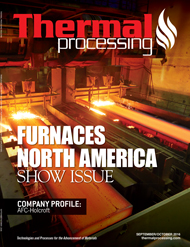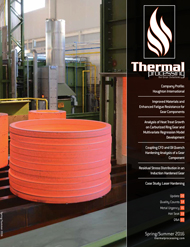Archives
September 2016
Heat Treating Education
In a recent paper by Janusz Kowalewski of Ipsen at the 3rd International Conference on Heat Treatment and Surface Engineering in Automotive Applications held in Prague, May 11-13, 2016, several global trends in heat treatment were identified. One trend is that the demand for heat treatment, services, and equipment is growing at a faster rate […]
Hybrid Forging: Advances in Open Die and Closed Die Forging
Today’s high-strength material users are increasingly obliged by everyday economic and competitive realities to seek alternatives to their current manufacturing processes. The reality that forgings can be used for more than simple parts — and forged at very large sizes and unique geometries — is slowly being realized. Companies who are looking for a better […]
Single-Piece, High-Volume, and Low-Distortion Case Hardening of Gears
Global output of the automotive industry reached 86 million vehicles in 2014. Each vehicle is fitted with a transmission gearbox (see Figure 1). Ninety percent of these gearboxes are traditional automatic or manual, with gears being the main component (see Figure 2). Modern automatic transmissions have eight to ten steps with multiple gears for each […]
Detrimental Effects of Sulfur on Transverse Impact Properties in Steel Forgings
Anyone who has supplied or processed forgings for the power generation, oil and gas, or shipbuilding industries, among others, is familiar with Charpy impact testing requirements. The test is intended to ensure parts have adequate impact toughness in one or both grain flow orientations. Because this test is usually performed simultaneously with mechanical testing on […]
Carburizing and Nitriding Treatment Modeling
(Photo courtesy of Advanced Heat Treat Corp.) Carburizing and nitriding treatments have the same goal: increase hardness on the surface while keeping the core ductility. Carburizing is a process where the part is placed in a confined environment regulated by its carbon content. By adjusting the parameters such as temperature and time, the carbon will […]
April 2016
Improved Materials and Enhanced Fatigue Resistance for Gear Components
For decades, the gear industry has addressed the challenge to produce high-performance components in a cost-effective manner. To meet design intent, vehicle transmission components need to be heat treated. In many applications, the high demands regarding service life of components can be reached only by the application of a customized case hardening. This case hardening […]
Analysis of Heat Treat Growth on Carburized Ring Gear and Multivariate Regression Model Development
In gear manufacturing and machine assembly, dimensional stability of each component and conformance to print requirements are of critical importance. During processing, dimensional changes associated with each manufacturing step must be consistent and predictable so that the final part size conforms to the print tolerances and assembles properly. Misalignment of the assembled components may cause […]
Coupling CFD and Oil Quench Hardening Analysis of a Gear Component
Today, powertrain development is driven in the direction of weight reduction by replacing heavier components with low-cost or higher strength alloys for industries such as automotive, aerospace, and process engineering. Accurate prediction and optimization of the heat treatment process of metal parts is important to achieve optimum material properties or to increase the magnitude of […]
Residual Stress Distribution in an Induction Hardened Gear
A vast majority of steel gears are heat treated in order to obtain the desirable properties of a final product such as a high wear resistance and a long fatigue life. There are numerous heat treating techniques available today. Which one is chosen depends on many factors including the required hardening pattern, allowable distortion, post-heat-treatment […]
Case Study: Laser Hardening
To increase the hardness of a steel material, there are basically three required steps in the hardening process. Step one is to heat the material, step two is to keep the temperature above a certain hardening temperature level for a certain time (dwell time), and step three is the quick cooling of the part, often […]



























